
This year’s e-learning content trends
Interview with Falk Hegewald, Director E-Learning at imc
Out with the old, in with the new. A new year brings new content trends that nobody involved in corporate learning can afford to ignore. Together with Falk Hegewald, Director E-Learning at imc, we are taking a look at the coming year’s crucial topics for companies.

INFO
Falk Hegewald started out in design: He studied graphic design and followed that up with game design. But when imc introduced him to the e-learning sector nine years ago, he decided to stay put. “Back then, I was attracted to the idea of creating something new in this world of e-learning. It was all still very 1990s in those days,” says Hegewald. At imc, he is responsible for custom and off-the-shelf content worldwide.

Now, we’re really getting started: 3D, VR and Metaverse
Falk Hegewald is confident that the upcoming big changes are here to stay – well beyond 2022. Many major corporations are driving the development of virtual reality and metaverse. Nike recently acquired a design studio that “produces” NFTs and virtual running shoes.
“The key driver for metaverse is to create a world where you can play. However, that world will also feature workspaces. We are already entering that world with virtual meeting rooms,” Hegewald explains. “At imc, we are taking that as an incentive to develop the 3D aspects of our content to gain a head start in the creation of such digital worlds and environments.”

INFO
Metaverse:
Metaverse describes an immense collective virtual space formed when real and virtual worlds merge. A metaverse comprises both open and closed platforms. Companies can create their own worlds as well as digital products, and even sell them there – just like in the real world.
Engaging content and adaptive learning
This year will also see a strong focus on more engaging content that both motivates and captivates the learner. Not everything needs to be a game, Falk Hegewald claims: “You can also use novel engaging activities and formats. There is already demand for inspiring training, as companies have realised that they need to get more buy-in from their employees. As a premium content provider, we can deliver that.”
Adaptive learning will also be very relevant for content in the year ahead. In the past, the focus was on learning management systems featuring intelligent interfaces that facilitate appropriate distribution of training courses. Now, we are moving towards skill management through content. Falk Hegewald is confident that adaptive e-learning content will be in demand this year. “You rarely need everyone to learn everything. Employees with different levels of knowledge attend the same training course. Testing prior knowledge and leveraging suitable tools to assign content becomes a whole lot easier if the content is adaptive, too.”

Adaptive learning
Premium off-the-shelf content will be big next year
Last year, Falk Hegewald was particularly excited about the "Cyber Crime Time"awareness game, which deals with IT security issues by letting the learner take on the role of a hacker. Step by step, they learn the most common cyber-attacks first hand. “This goes well beyond your typical off-the-shelf content, be that from us or from our competitors. We wanted to create something that gets the employees’ attention.”
Yet, that was only the first step: This year, Cyber Crime Time will be expanded to include additional training courses and learning nuggets – smaller learning units. “Our aim is to create an entire training world for IT security so Cyber Crime Time remains exciting for our customers,” Hegewald explains.
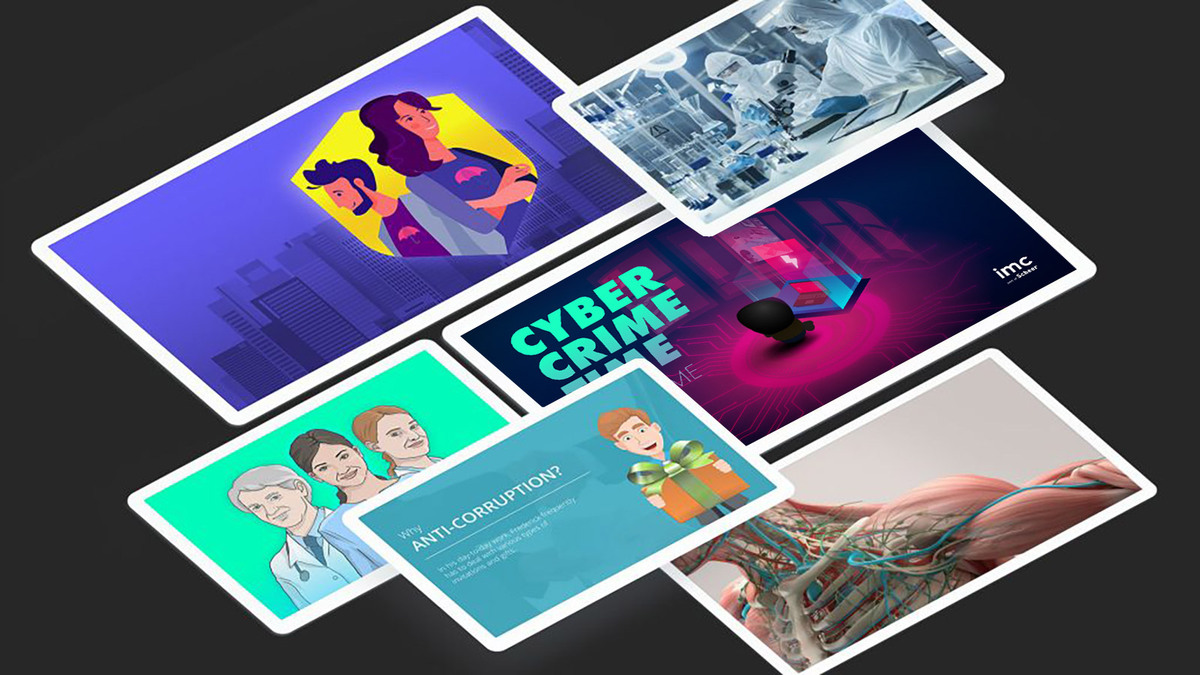
Premium Standard Content of imc
Falk Hegewald’s department also had their hands full designing custom content for corporate clients throughout 2021: They created a wide range of complex learning content, as well as complete digital learning journeys – covering everything from onboarding through corporate strategy to exciting sales training for customers like Jägermeister. “Generally speaking, many of our customers were more daring in their content design and presentation this past year. We love that trend and believe there is room for even bolder creative moves in the stories and the design,” says Hegewald.

The Jägermeister Master Academy
The war for talents goes into the next round
Companies are forever looking to attract talents and retain them long-term. The right onboarding and employee development are playing an ever-greater role in this quest.
To feed into that ambition, it is important that professional development content is up-to-date and dynamic. Falk Hegewald explains: “Young talents joining the job market are used to a different pace, they use media in a totally different way. It can become very challenging for a company to keep them engaged.”
That is why a key aspect will be to make onboarding and professional development courses accessible on all devices, enabling the latest generation of employees to learn anytime and anywhere.
As Head of the Division, Falk Hegewald always gets excited when new colleagues bring fresh and interesting ideas, as is often the case when they join straight out of university. “This type of inspiration is vital. As a content department, we always need to keep an open mind for new ideas.”

As Content Director, what are you looking forward to this year?
“Exciting new customers and new client projects. Personally, I would really like to visit the other imc locations again and meet the employees I have not yet had any personal contact with.”
Well, here in Saarbrücken, we are looking forward to meeting you, Falk!

Gamification takes corporate learning to a new level
The fact that game-based learning works as a motivational booster for e-learning is already anchored in childhood. We have summarised the most common types of games and practical examples of possible applications for you.
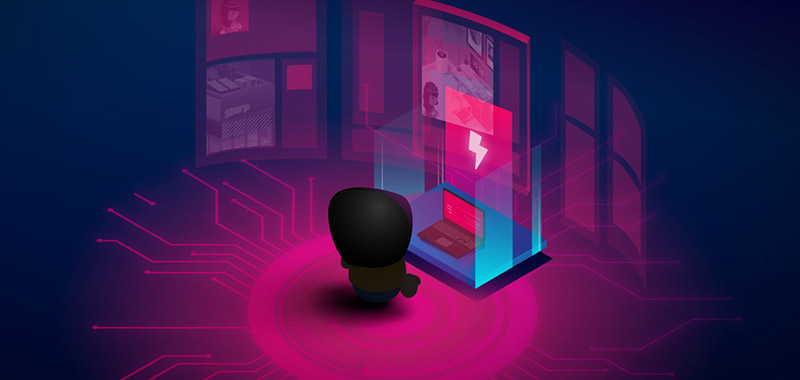
Awareness trainings are the key to success in the prevention of cyber attacks
Cybercrime is on the rise. It is no longer just a handful of criminal hackers who want our data and, unfortunately, our money. Learn in this article how awareness training can improve your IT security.
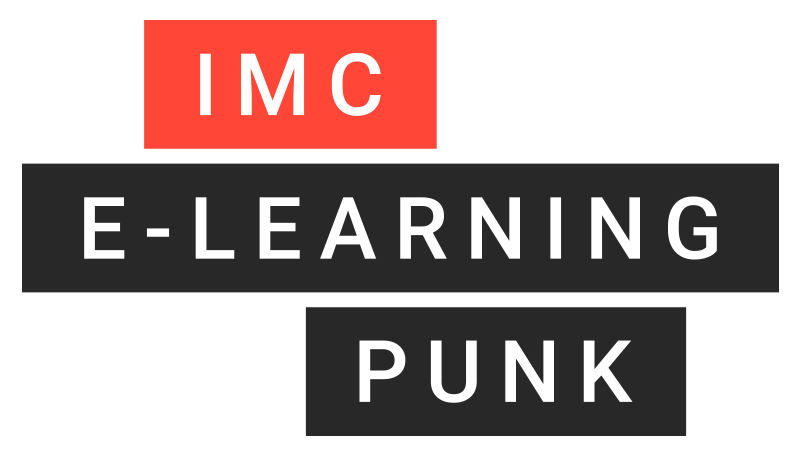
Contact person
I joined the imc newsroom team in 2021. As a journalist my heart beats for content and storytelling.
I’m excited to figure out how e-learing and digitization affect the future of work. My task is to create content to talk about and I’m always looking for trends.
Privately I love to travel and eat Tapas.
Topics: E-Learning Trends, Corporate Social Responsibility, Press and Influencer Relations
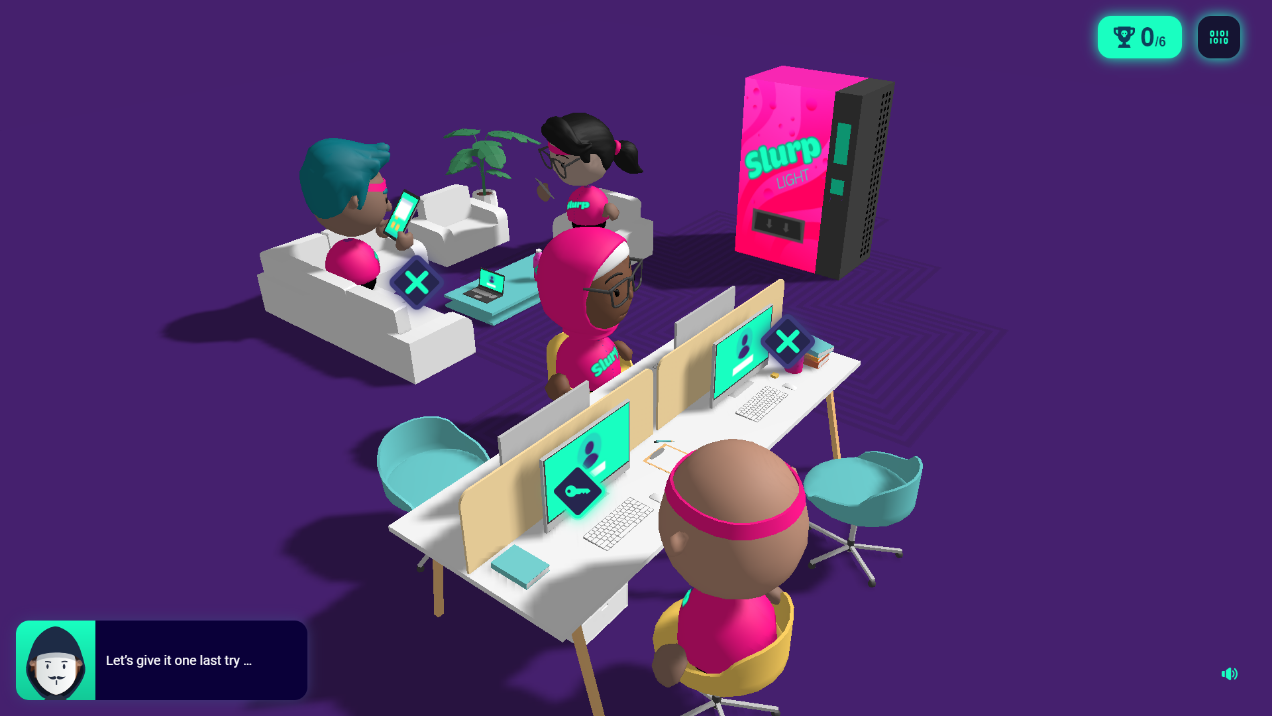
Awareness training: The key to success in preventing cyber attacks
There are two types of companies: those which have already been hacked, and those that will be hacked in the future.
Mobile data, free internet access and remote work make us flexible – and a target for attacks. Cyber criminality is on the rise. Gone are the days where only a handful of hackers tried to obtain our data and – sadly – our money.
To protect themselves, companies must establish effective IT security management. Simply implementing technical measures is no longer enough. The human factor – each company employee – is the most crucial component for successful IT security. Awareness training can be leveraged to sensitise employees to the dangers of cyber-attacks: Knowing about potential dangers helps to stave off criminal hackers.

Cybercrime comes in many forms
A hacker need not have programming skills. Social hacking, for example, involves the perpetrator calling selected persons, asking them for their password for ostensible reasons. If the victim actually reveals their password, psychological and linguistic tricks are employed. The technical skills one would typically connect with the term “hacking” are not used.
This makes it even more important to sensitise staff to such threats – they are dealing with a vast array of them. Few people know offhand what malware, ransomware, identity fraud, phishing or social engineering is all about.

Roman Muth, Security Officer and director of cloud solutions and architecture, imc AG
But wait a minute! Not only big enterprises and publicly listed corporations are potential victims, Roman Muth, Security Officer for Cloud Solution and Architecture at imc AG shares: “Recently, SMEs have often been targeted by cyber criminality, since large corporations tend to be better protected these days. However, the tactics are similar. The masterminds first approach employees to identify vulnerabilities and obtain information they can use to damage the company, and maybe even blackmail it and extort money.”
Creating awareness through gamified learning
To create a lasting impact, employee training needs to start with sensitising employees and creating awareness.
No matter how abstract the subject, training needs to do two things to be fully absorbed and understood by the participants: It must capture their attention and show how it is relevant for their day-to-day work. Theoretical constructs that seem foreign to employees and have little to do with their reality at work are forgotten before they even click the final tab.
That is why imc developed an awareness game: to help learners grasp the issue while motivating them to dive deeper into IT security.
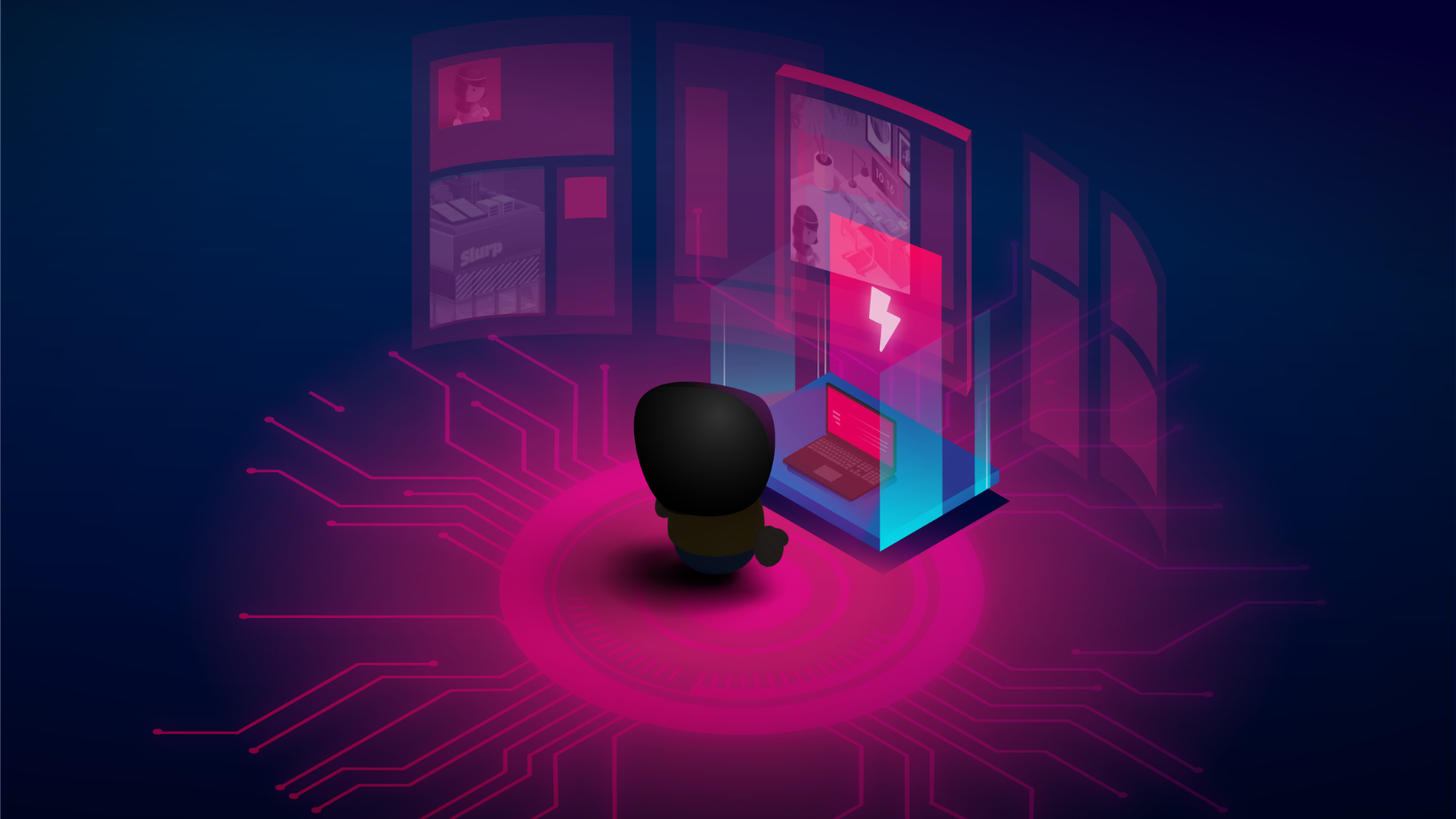
Cyber Crime Time lets the learner slip into the role of a hacker. Step by step, they learn the most common cyber-attacks first hand. The learner – or hacker – gradually adds to their “hacker toolkit” to obtain secret information through the employees of a fictional company.
Once their personal ambition to hack this company and fulfil the secretive client’s order is aroused, the most important rules for preventing cyber-attacks are virtually picked up by the way.
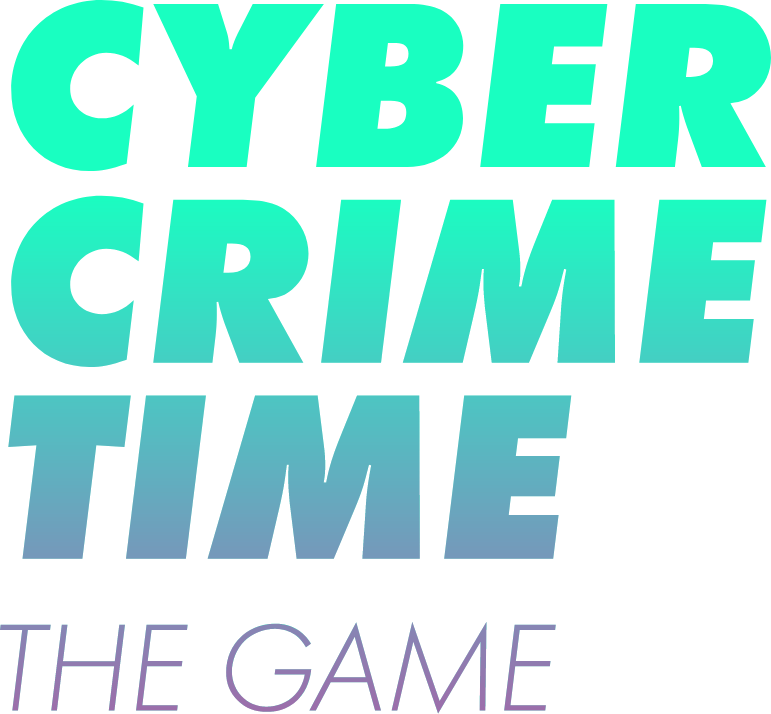
GOOD TO KNOW
Cyber Crime Time can be integrated into any Learning Management System (LMS) and added to the corporate standard training package. A personal hacker experience is also possible without LMS integration: The online version can be played on any device and is even available free of charge on a single-user licence.

Gamification takes corporate learning to a new level
The fact that Game Based Learning works as a motivational booster for e-learning is already rooted in childhood. We have summarized the most common types of games and practical examples of possible applications for you.

Computer Games in Professional Development
Competence transfer thanks to digital games? It's possible! In an interview with Çiğdem Uzunoğlu, we explain how computer games and continuing education fit together and how they can be used effectively.
Contact Person
I joined the imc newsroom team in 2021. As a journalist my heart beats for content and storytelling.
I’m excited to figure out how e-learing and digitization affect the future of work. My task is to create content to talk about and I’m always looking for trends.
Privately I love to travel and eat Tapas.
Topics: E-Learning Trends, Corporate Social Responsibility, Press and Influencer Relations, New Work

Six vital modules for every digital onboarding concept
A blueprint for efficient onboarding with lasting impact
Different companies have different requirements for their onboarding process. They might want to use modular and future-proof concepts, achieve cost and time savings compared to current approaches, or enable employees to start working sooner. Moreover, the pandemic has accelerated the need for digital onboarding as face-to-face training has not been possible. Despite the pandemic introducing more relaxed, remote working arrangements, hybrid work arrangements will become the norm; hence digital onboarding will become the tool to deliver a great first experience to new employees.
Yet, companies are not the only stakeholders – Employees have their own expectations of the onboarding process. This is why many HR managers are deciding on learner-centric onboarding that revolves around the needs of new employees:
“I want to know what makes my company tick,” – “I want to feel like I’m becoming part of the community,” – “I want to improve my skills.”
To achieve that, your onboarding needs a framework that provides guidance and an emotional connection while assessing the current state of knowledge and developing expertise.
This article explains how to design an exciting and creative digital onboarding process with new and existing e-learning content, even without a learning management system (LMS).

An illustration of the key building blocks
Our experts are always developing concepts suitable for a wide range of requirements. Get a head start with our “best of” compilation. Let’s imagine this situation: You want to digitise five days of basic training that has always been conducted on site. You are looking at a very diverse group of participants. The target group for this training extends beyond new colleagues, and also includes “old hands,” as well as some external service providers. They each have a different level of prior knowledge, different hardware, and different levels of access to a learning management system (LMS). Some might not have any access at all.
How do you satisfy them all? The solution is to design a structured framework for digital onboarding. Our experts recommend getting a head start with these 6 modules:
- A central (digital) starting point
- A daily virtual kick-off
- The self-learning phase
- A virtual hands-on workshop
- The online quiz
- A learning diary
Together, these six modules form a foundation. Let’s look at each element separately.
My Digital Onboarding Kit – The modules in detail
The central starting point could, for example, be a browser-based landing page created especially for onboarding, a homepage in the company intranet, a portal page (in the LMS) or an interactive PDF. It is important that the employees can see at a glance what is on the agenda for the day when they arrive for their onboarding. Think of it as a modern timetable. Every new employee needs structure, and an overview page is an easy way to provide that.
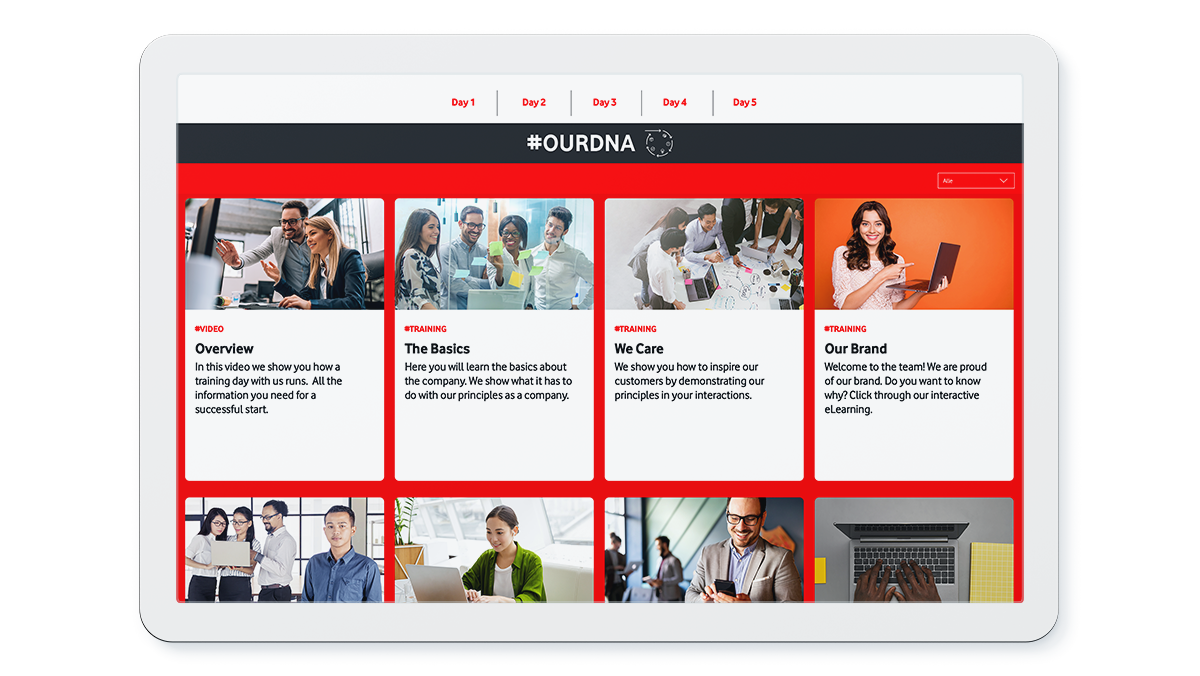
Portal page as central starting point
The virtual kick-off at the beginning of each training day serves to agree and discuss the agenda and objectives for the day together with the trainers. The focus should be on social onboarding, on promoting interaction between the participants. Our experts recommend a playful warm-up with surveys, icebreakers, or activation games aka energisers. Why not play a round of “I packed my bag” to get started? It is helpful to establish a meeting netiquette, specifying that cameras and microphones must be switched on.

virtual kick-off
In the self-learning phase, each learning format achieves a specific objective. For example, digital performance cards help employees gain knowledge with a certain focus, and then apply it in simulations as part of web-based training. Virtual scavenger hunts help them familiarise themselves with the company or the intranet. Companies can also integrate existing training courses or offer individually tailored or branded content. Variation between different e-learning formats has proven particularly effective.
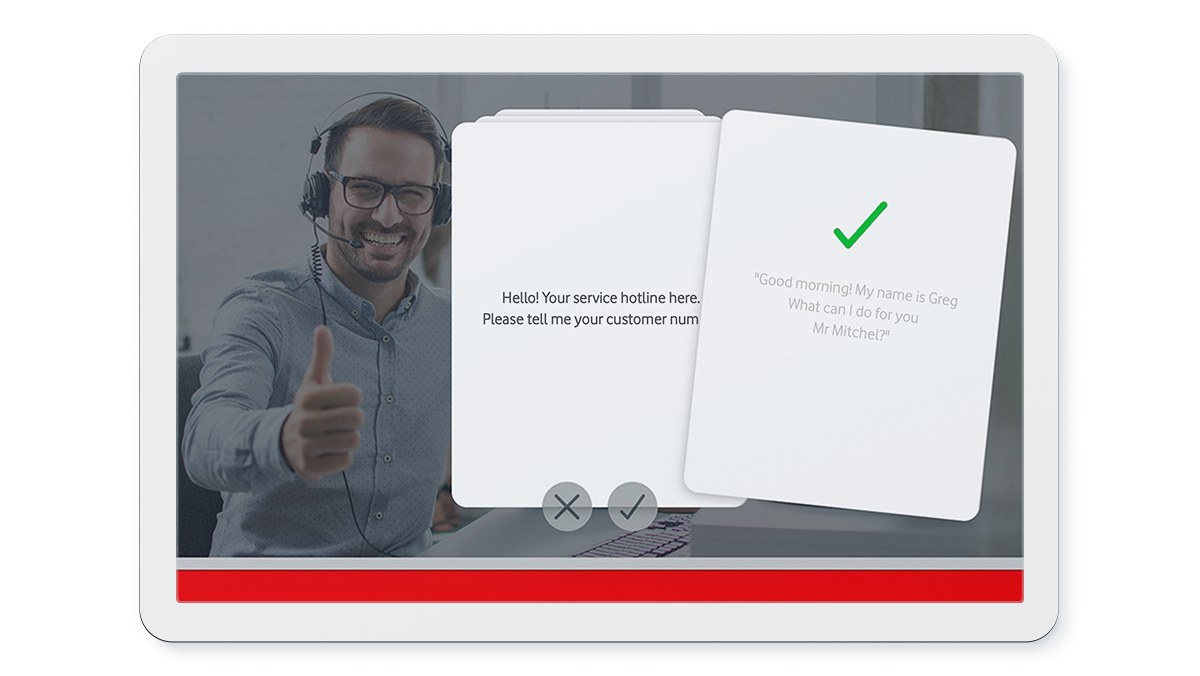
Performance cards
The hands-on workshop moderated by the trainers gives the employees an opportunity to apply what they learned and clarify any questions or uncertainties. This could include polls, multiple choice questions in the group chat or whiteboards.
The online quiz concludes the day. One great example is the BizQuiz. It provides participants with feedback on their learning progress and gives them the opportunity to close any knowledge gaps.
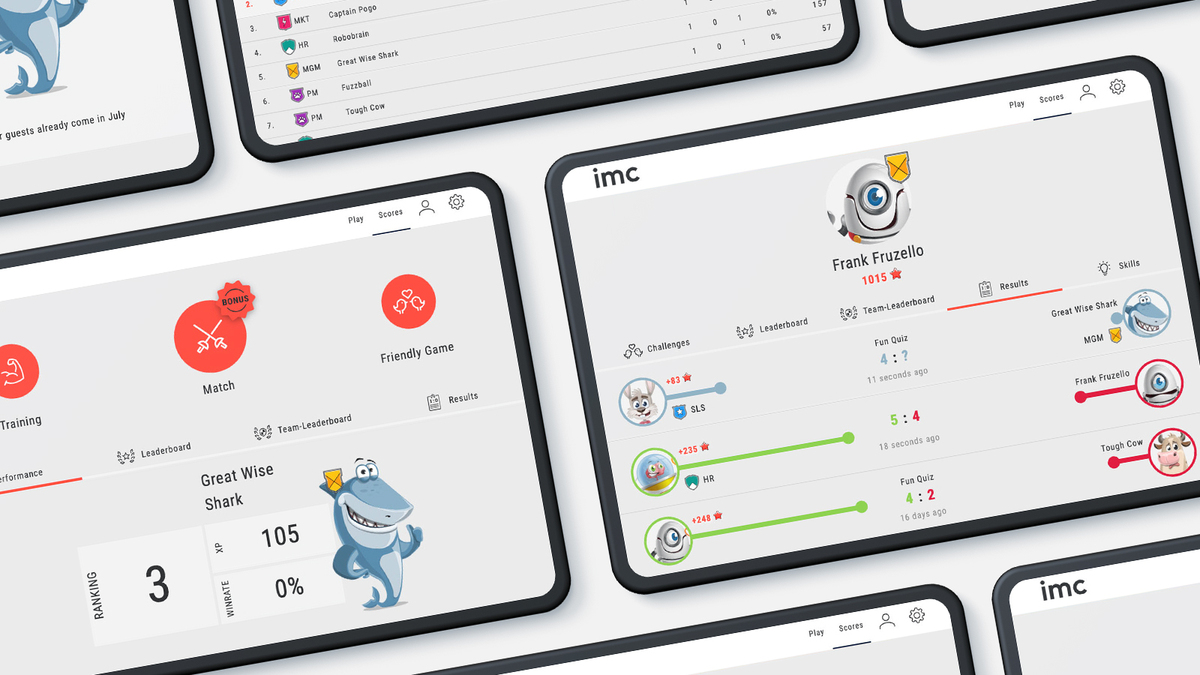
quiz app: Biz Quiz
Finally, the learner makes their personal entry in the learning diary. An easy way to integrate the diary is to design a page in the intranet, a document in the cloud or a form that mirrors the central starting point, and which each participant completes for themselves. This serves to summarise the core messages from the workshops or formulate the questions and tasks for the self-learning phase, as well as compiling key insights from the training courses. The personal learning diary thus becomes an individual reference resource participants can look things up in long after their onboarding.

Learning diary
GOOD TO KNOW
Time investment for trainers is automatically reduced
The targeted use of digital learning formats in the self-learning phase reduces time investment for trainers during digital onboarding. That saves costs and resources. Following this 6-module approach, trainers are only required for the kick-off and the workshop phase.
Digital vs hybrid onboarding
Digital onboarding works. This approach can absolutely be appropriate while also saving resources. Nevertheless, some onboarding processes are easier to realise in a hybrid format. Of course, that does require new employees to travel to the location.
One example for a good hybrid solution would be to communicate theoretical content through online self-study, and then bring participants on site to carry out specific actions, such as operating machinery. The face-to-face part of the training can then be utilised for practical exercises and to clarify questions.
Similarly, a dual approach helps with understanding the corporate culture. For instance, companies might invite new employees for an intro day before their first day of work. Make the most of this day by asking colleagues to talk about how they realise the values, objectives, and mission of the company in their daily work. This meeting can also be leveraged to establish an emotional connection with new recruits and build enthusiasm for the company.
In our experts’ experience, it is not as clear-cut as one approach being universally better. Rather, it is about selecting suitable formats and linking them in a helpful way based on the new employees’ needs and the learning objectives.
We linked a special treat for anyone interested in hybrid onboarding:

Digital Learning Journey
Reaching the destination with the right blend of formats: Digital learning journeys capitalise on the strengths of each learning format to create a motivating learning experience.

LMS Hot Topics: Science fiction or near future?
Onboarding can already be integrated into existing learning management systems. But Hanna's example shows that this is only the beginning.

Contact person
I joined the imc newsroom team in 2021. As a journalist my heart beats for content and storytelling.
I’m excited to figure out how e-learing and digitization affect the future of work. My task is to create content to talk about and I’m always looking for trends.
Privately I love to travel and eat Tapas.
Topics: E-Learning Trends, Corporate Social Responsibility, Press and Influencer Relations
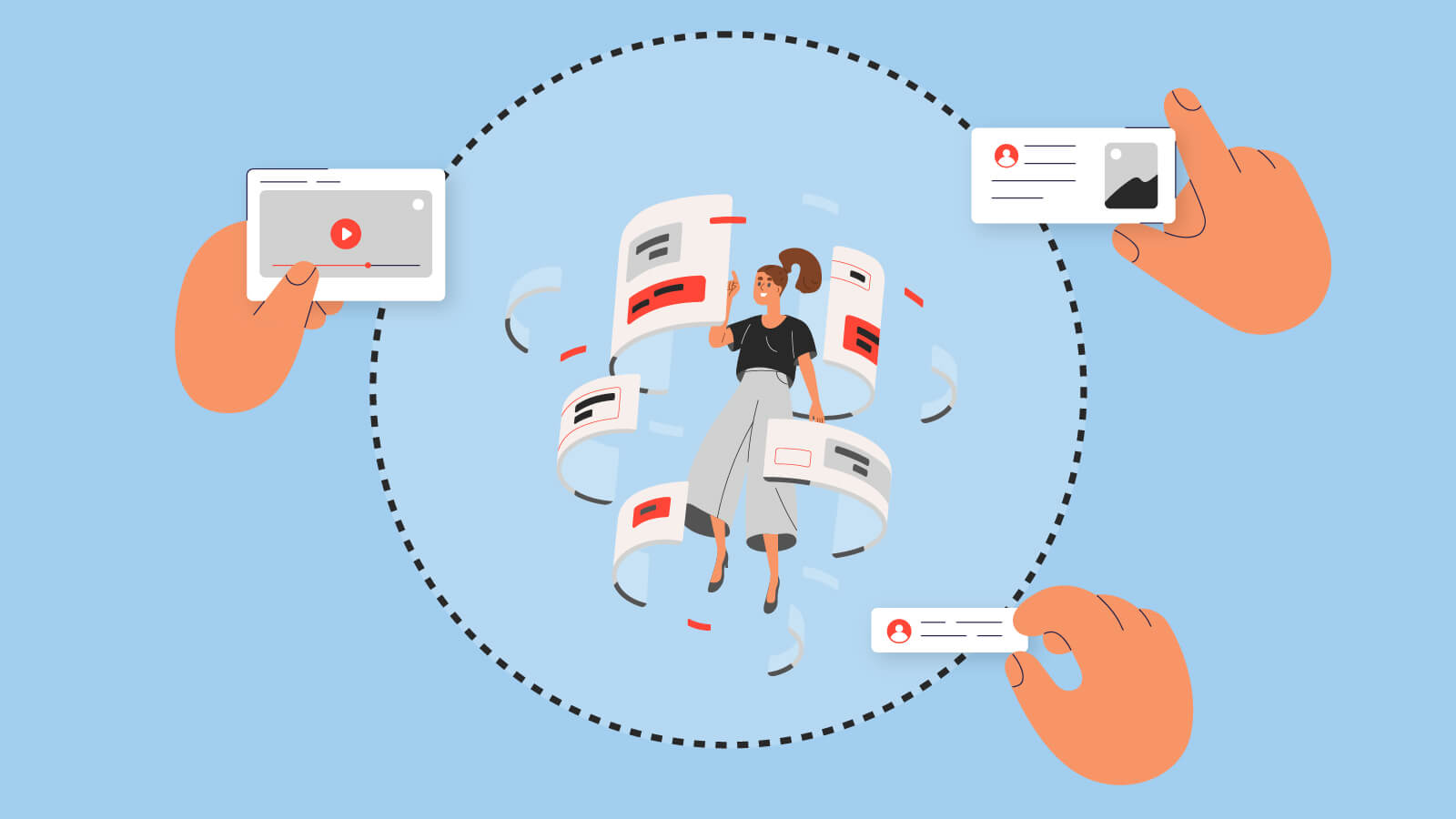
Design thinking with a human perspective
When done well, human-centred design can resonate deeply with its audience. We're looking into the importance of using this technique in e-learning and how it can look like in a practical example from Australia.
Have you ever heard the term human-centred design and wondered what it meant? Well, in a nutshell it describes the design of e-learning solutions that focus on placing learners in situations they experience every day.
Imagining human-centred design
Human-centred design works by actually imagining the experience of work, learning, and problem-solving from the perspective of the employee. Also known as user-driven design and design-thinking, the idea is to build e-learning content with the user in mind by asking them what they want.

How effective is this?
For human-centred design to be effective, e-learning designers must set aside any preconceived ideas they have about how things should work, how learners “should” do things, or what they “should“ know. These assumptions need to be replaced a deeper understanding of their actual experience.
How should a designer do this? Well, the easy answer is to observe and research.
What do human-centred design observation and research look like?
The effective observation and research to successfully capture the human-centred approach are quite simple. Designers would need to consult and collaborate with the end-user. They would need to immerse themselves in the world of an employee, engage with them, ask them questions, get to know their work environment, watch them work to gain an accurate understanding of what it is like to be in their shoes.
For human-centred design to work well, it requires a holistic “hands-on approach” to understand how employees approach their work and why they do things the way they do.
The steps of human-centred design
After consulting with the employees to understand their specific needs, a designer would draft a ‘finished enough to test’ plan of the e-learning course.
The next stage would be to hold a video conference with users and walk them through the plan, taking in any feedback they may have. Once feedback has been incorporated, the building of the e-learning course will take place. After this, designers would need to have the users test it again.
Basically, these last few steps would be repeated until the e-learning content is refined enough that it is ready for publication!
A practical example: State of Victoria meets imc
The imc team utilised the human-centred design approach to find a solution for the onboarding of new staff to the Victorian Department of Health and Human Services (DHHS). With collaborations and workshops, we worked closely with the client and their subject matter experts to understand what separates DHHS and makes them a leading workplace for new employees.
The main aim of this module was to make new starters feel connected to the organisation, their role and how they are part of the bigger picture for DHHS.
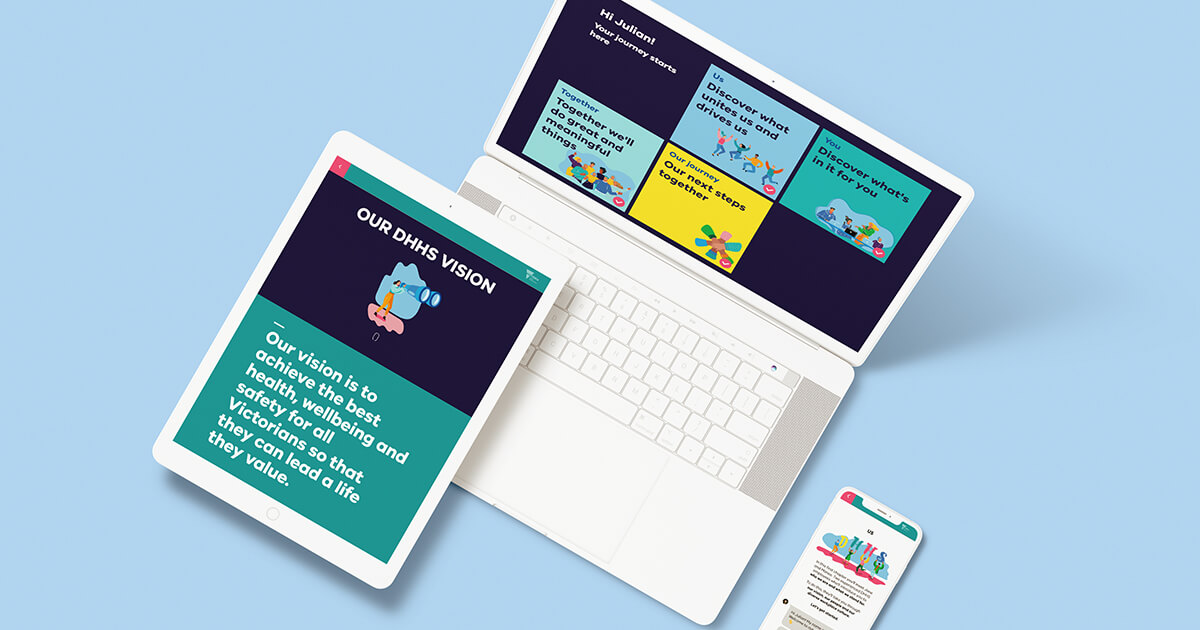
A human-centred solution
Through fresh, modern design and chatbot interactivities, we created a module that welcomes a new employee to the DHHS on an organisational and cultural level in an inviting, warm and friendly way.
Employees can now navigate through human-centred modules using computers, tablets or mobile as it is optimised for all platforms.
Focus on the learner, please!
For us to really understand and empathise with our learners, we need to be talking directly to our target audience as best we can.
Too often, e-learning can make the mistake of focusing on the training itself rather than the target audience.
By going out into the field and meeting with our learners, the human-centred design provides the best way possible to build up an accurate representation of the people we are hoping to inform and educate. This, in turn, leads to e-learning content that is both engaging and practical.
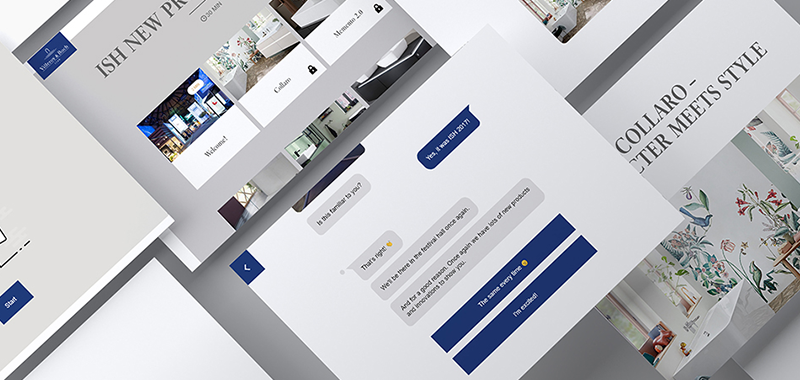
Conversational Chatbot Learning
Advantages of using chatbot to create interactive learning experience.
Contact


Rapid Content Development: Creating E-Learning Trainings Quickly
Why fast creating digital trainings is possible but risky
... and suddenly, the training had to be scrapped. Many companies made that experience in lockdown number one. Employees needed to be trained, but the training was postponed due to Corona. Again. And again. However, most types of training simply cannot be endlessly postponed or even be cancelled altogether.
A pragmatic and swift solution is needed – training needs go where the employees are: their home office. For many companies, that means digitising learning content, and doing so quickly. They need rapid content development. This trend was already apparent before Corona, but the pandemic greatly increased the demand for the technologies that facilitate rapid content development.
This article explores what qualifies as rapid content development, what type of learning content is suitable for rapid digitisation, and what risks a strong focus on speed entails.
INFO
Definition: Rapid content development (RCD) is an agile model for teaching system design, comprising a preparation phase, an iterative design, template-based re-usable components and e-learning tools for quick and cost-efficient provision.
Speedy please – but without quality loss
We want things now: fast food, coffee to go, messenger services, online shopping … we no longer have time. Companies have also clocked onto this trend, and want to stay up to date with their training courses. An ever-increasing amount of knowledge is expected to be available almost instantly on various media while maintaining a high quality standard and staying within budget.
The solution: rapid content development. But wait a minute! No matter how fast you go, the quality of the overall learning solution must not be compromised. That’s why learning experts like Eva Lettenbauer always look at the big picture.

Eva Lettenbauer, Specialist Learning Experience Design at imc
Hi Eva, thanks for “quickly” making time for us. How did you experience the rapid content development hype last year?
Especially at the beginning of the pandemic, many companies were facing the challenge of having to digitalise their face-to-face training in a short space of time. However, directly transitioning classroom-based training courses to a virtual classroom or web session is not always effective, and it’s most certainly not efficient.
That is why we always examine the specific issues and objectives. This allows us to digitise specific learning content in a way that drives outcomes and boosts performance.
How do you handle requests for “rapid” content?
Since requirements differ as widely as the type of knowledge to be conveyed, digital solutions vary enormously. We start by analysing the sharable knowledge and the desired outcome. We also examine if the integration of certain existing learning solutions or curated content would add value, and examine the suitability of different learning infrastructures. Finding the right formats for the content at hand has to be a priority, as this then allows new content to be created quickly and systematically.
What risks does rapid content development involve, and how do you avoid them?
There is a risk of quality loss – creating too much content while neglecting quality, or losing sight of the target group, their performance or the intended business outcome when designing and creating content. This can make the learning solution irrelevant and ineffective. Often, less is more. It pays to take a closer look and be more deliberate when starting the rapid content development process, and avoid such mistakes.

When would you recommend slowing down?
Whenever learning corresponds to behavioural changes, aims to change the learners’ mindset, or the branding, look or feel of the learning solution are important, investing time to achieve a high-quality solution is paramount. This is the only way to gain the learners’ lasting interest and make them believe in digital learning approaches.
GOOD TO KNOW
Authoring tools enable companies to create learning content themselves or digitise existing material. This facilitates a flexible response to learning requirements within the company.
Authoring tools are cost-effective and allow both internal experts and other employees to create training courses. This is also known as user generated content.
What are the limits for content creation with authoring tools?
Authoring tools like imcExpress are ideal for quickly creating and sharing content based on facts or background knowledge. Digital learning content can be created quickly and – crucially – kept up to date. However, no learner should be trained exclusively with web-based training courses. Especially if their development involves the application of specific practical skills, traditional web-based training is seldom enough – but that is all an authoring tool can deliver.
What would a worst-case scenario look like? How “not to” do it?
Worst case: 5 days of face-to-face classroom training is taken “as is” and squeezed into a 3-day training course in a virtual classroom. Endless recordings of face-to-face training or web sessions replace the on-site presentation of the material.
Best case: A 3-day face-to-face training course is digitalised and broken up into various learning nuggets like short web-based training courses, complemented with learning tandems, snappy web sessions and curated content.
How about a quick summary? Happy to be at your service:
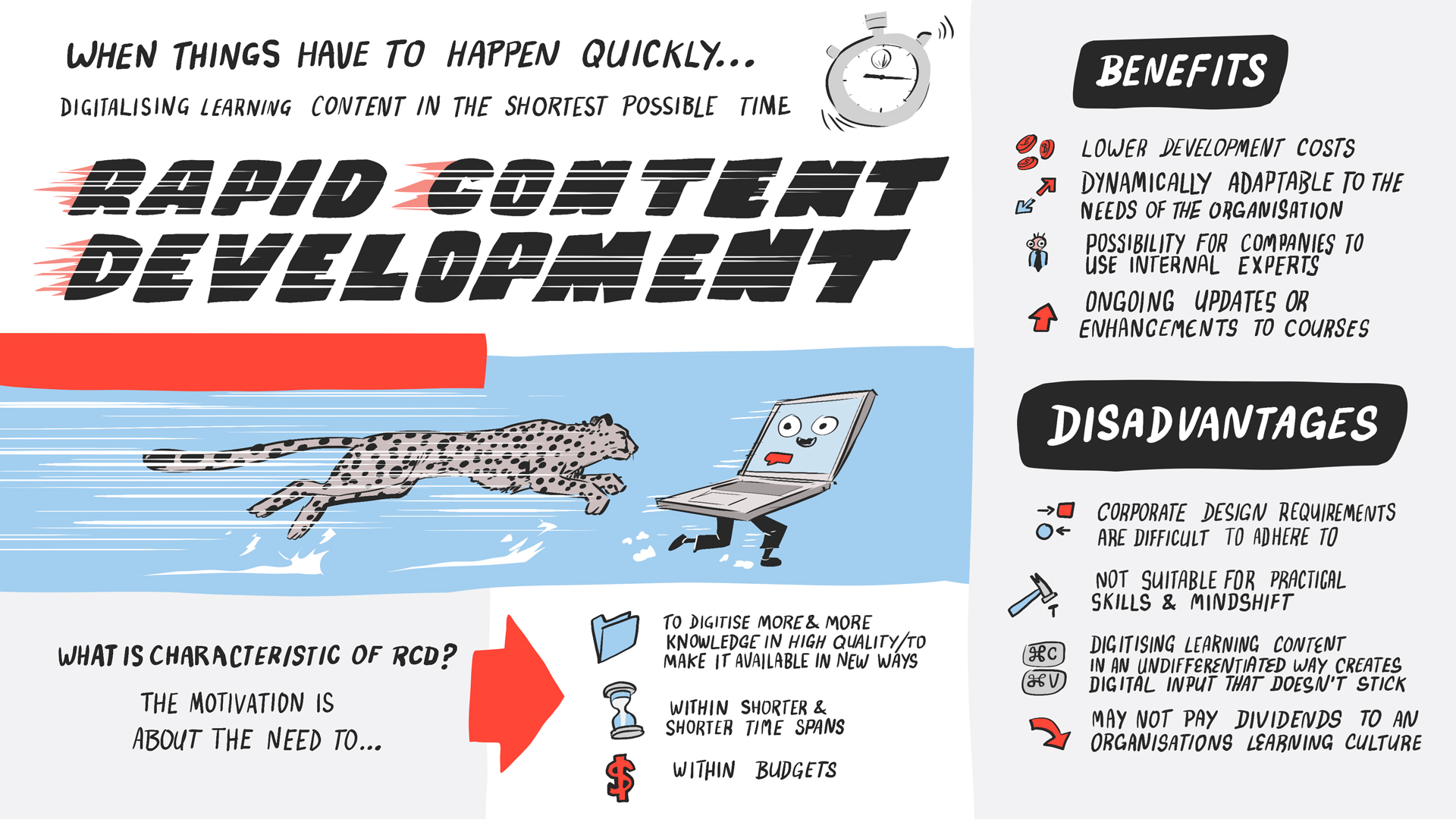

Digital Learning Journey
Reaching the destination with the right blend of formats: Digital learning journeys capitalise on the strengths of each learning format to create a motivating learning experience.

User-generated elearning content meets artificial intelligence
Creating learning content has nerver been that easy. Oliver Nussbaum and his team developed a new AI-driven authoring tool called imc Express.

Contact person
I joined the imc newsroom team in 2021. As a journalist my heart beats for content and storytelling.
I’m excited to figure out how e-learing and digitization affect the future of work. My task is to create content to talk about and I’m always looking for trends.
Privately I love to travel and eat Tapas.
Topics: E-Learning Trends, Corporate Social Responsibility, Press and Influencer Relations
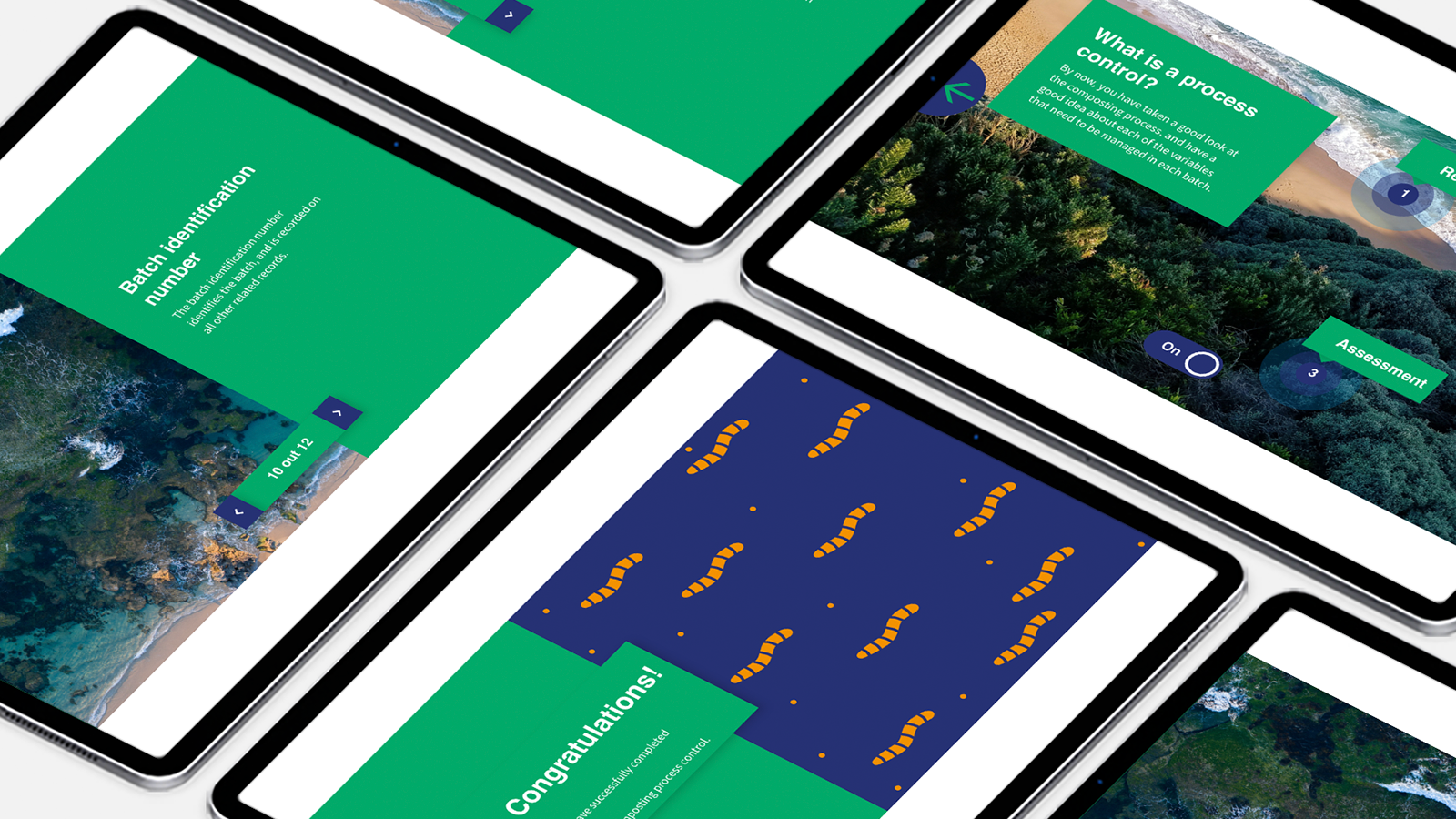
Learning with chatbots
Chatbots have advanced so far that it can sometimes be harder to distinguish between robots and humans. Learn more about how chatbots can be incorporated into corporate training to develop engaged employees.
Chatbots are being increasingly deployed as an important channel of contact. As a tech tool, along with phone and email, plus real human agents, they are becoming a vital point of contact for customers getting in touch with a company.
In addition, it has been used in e-learning content to create an interactive learning experience by using informal languages and creative GIFs. Effective conversational learning with real-time response is one of the advantages of chatbot learning.

Connecting with the consumers using a chatbot
LivePerson’s Consumer Preferences for Conversational Commerce survey found two-thirds of consumers would like to message with brands. Again, this reflects a preference for consumers to do business with companies that answer questions immediately.
Australian consumers are among the highest levels of chatbot users worldwide. Consumers particularly in younger age brackets, are interested in the convenience and ease that chatbot interaction can offer, but they can still be sceptical of bots and prefer human interaction.
However, when developed effectively, chatbots are extremely valuable and can offer a very unique way to forge a connection and develop valuable insights

Chatbots can become a robot teacher
Chatbot learning has evolved because we are now in an age where education has become more accessible than ever. We are constantly in pursuit of better, faster, and deeper ways to learn.
Adult learners are busy and rarely a priority to make time to learn, but utilising chatbot can change this tendency with spikes in productivity because of personable and knowledgeable training assistance.
Additionally, it can offer a welcome change to employees, with interactive training elements to engage them with high knowledge retention and put them in control of their own learning journeys.
What are the benefits of chatbot learning for organisations?
Some of the advantages of incorporating chatbot learning include:
- Real-time analytics dashboards, these measure the most commonly asked questions, track active and engaged learners versus learners who are not engaged, view the interactions that happen during off-hours, and evaluate learners’ skill development.
- They will encourage employees to be more productive and better placed to learn at their own pace when they need support.
- They can push out personalised information to learners.
- They can review and access all learner created questions and responses.
- They reduce the workload of trainers.
How can chatbots be used in corporate e-learning?
Integrating chatbot learning into your Learning Management System (LMS) environment can provide your organisation with additional data about learners.
This will significantly contribute to the process of learning because learners are using an interactive mechanism as compared to traditional e-learning systems. Digital learning with chatbot offers more personalised and effective learning, by giving learners direct access and control to information and learning stored in the LMS.
Let’s Chat Compost
An example of a conversational learning chatbot approach developed by imc Australia was deployed in the New South Wales Environment Protection Authority (EPA). The chatbot complemented the Compost Facility Management Training by teaching learners some of the basics of the main concepts in the e-learning program, such as Odour, Pasteurisation, Contamination and the Composting Process. It was also operating as a driver to motivate participants to want to learn more by going on to complete the Compost Facility Management course.
imc Australia used engaging design (Chatbot framework) and a conversational learning approach to teach participants about technical concepts involved in composting, using an informal and fun approach to gain their interest and inspire them to complete further study on the subject. You can register on the EPA’s learning management system here.
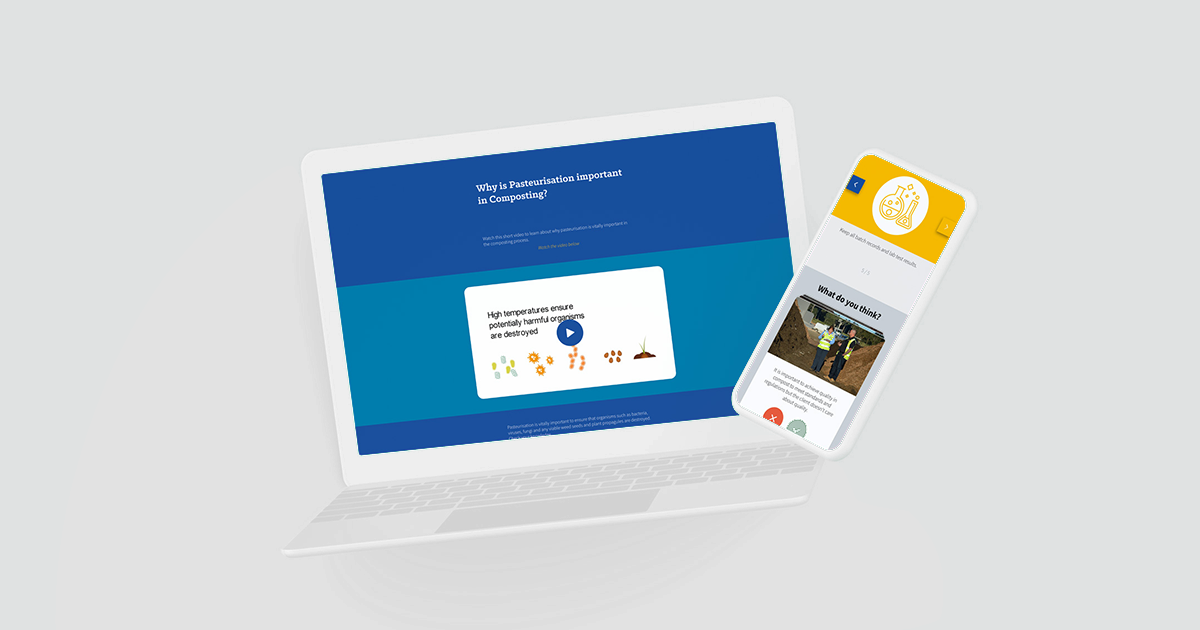
Chatbot learning utilises interactive elements
Moreover, imc created a chatbot that uses more informal language and uses GIFs as well as emojis to make it a more interactive experience for learners.
We have implemented GIFs within our chatbot learning because they can make learning more vivid and entertaining.
Here are some of the benefits of using GIFs in e-learning:
- They visually represent ideas and information in a few seconds
- They are easier to follow than a series of still images
- They usually run in a loop and are also perceived out of the corner of the eye
- They are much easier to create than higher-end video content
- They can play automatically on almost any system
- They trigger emotions. The stronger the emotion, the better the memory
What do chatbots mean for your e-learning
Chatbot learning can make a more productive learning process. It offers a more personalised experience for employees and also makes learning and development departments more efficient.
So, if you want to provide on-the-ball support and real-time personalisation for your learners, make your initiatives more productive and efficient, then a chatbot might be right for your organisation.

Gamified Learning to Drive Learner Motivation
How does gamified learning increase employees' motivation and help them build their skills in the workplace?

Villeroy & Boch Chatbot Learning
A successful chatbot learning combined with web-based training to urgently train 400 sales representatives worldwide.
Contact


I just want to play!
Why gamified learning increases employee motivation
How can organisations incorporate gamified learning to build the skills of their employees? In our digital world, organisations are more likely to invest in e-learning but are often challenged by low completion rates. Therefore, content needs to be taught in a playful way! We checked with some experts how this can work especially in Australia.

Our play instinct
When it comes to the concept of play, we usually think about the interactions of children. A child’s imagination is not the limit of play. This is demonstrated by the Latin term “homo ludens” which means “the people playing”. Our play instinct is very pronounced, regardless of how old we are. This is because games offer us a world of fun and creativity. We mostly play in a digital context in the modern world, and institutions and companies alike can take advantage of this through gamified learning.
A recent government study of Australian higher education students² found that only 46.6% of online students completed their qualifications. For face-to-face students, this is 76.6% by comparison. These statistics are problematic, because if learners fail to gain knowledge, then both time and money are wasted. It is vital that we present e-learning content in a playful way.
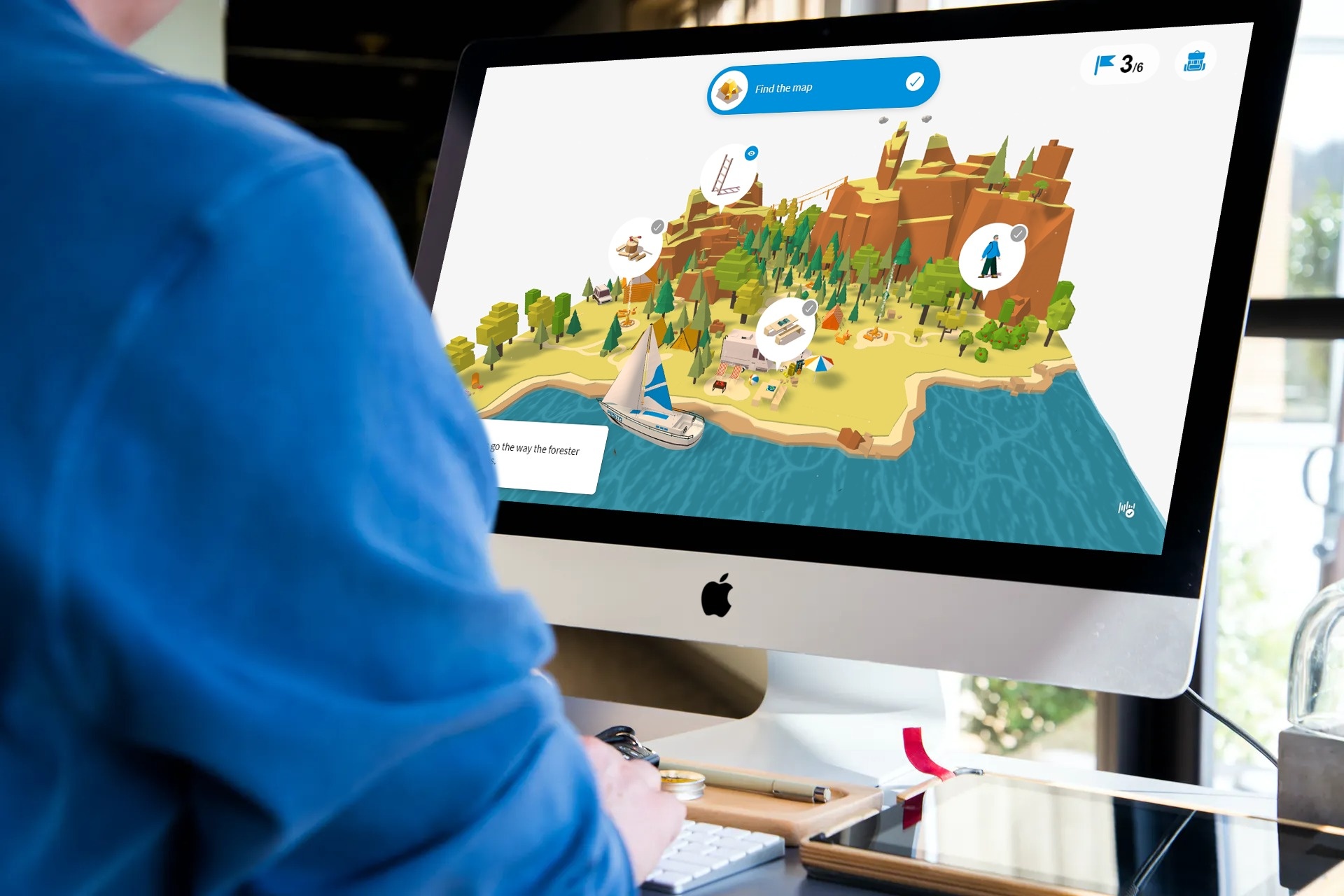
It’s time to get serious
Another sub-category of serious games is digital education games and gamified learning. Their primary focus is to impart knowledge. There are three types of serious games, these are:
Drill and practice games
The classic knowledge building games apps develop to build vocabulary or mathematic skills.
Quiz games
The BizQuiz app from imc is an example in which employees and entire teams can take part in engaging quizzes.
Point and click adventure games
Roleplaying games with enriched content and an exciting narrative.
The "City of Goods"
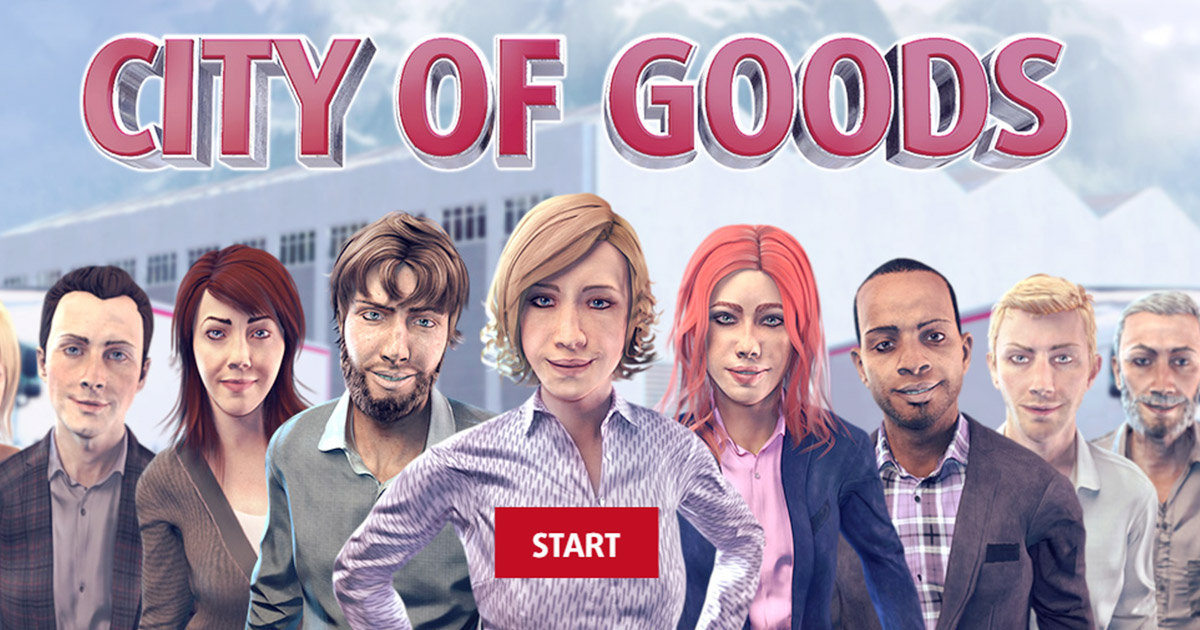
Learning through experience
The psychological benefit of gamified learning
Intrinsic
Extrinsic
Gamification is embedded in our everyday life. This can be through motivational tactics such as benchmarking (calorie or step counters) and nudging (such as point systems).
In summary, your employees are more likely to be motivated through gamified learning, when it is applied playfully.
Educational games can help reduce dropout rates and help employees build their skills in the workplace. Therefore: Game on!
This blog article is an extract from an article written by Sven R. Becker (A board member of imc AG) and Stephan Urbanski (Senior Instructional Designer at imc AG).
The original article was published in the I+MIO e-magazine (Available in German only).

Go for Game-based Learning
We talk about what lies beneath the trend of this playful knowledge transfer method. We explain why it works so well and present 3 application scenarios for game-based learning in the company.

Training soft skills with serious games
Softskills are more important than ever. But how to train them? imc's research team dealt with this challenge in the DEVELOP research project.
Contact


Gamification takes corporate learning to a new level
Why game-based learning boosts motivation
Scientists estimate that if we watched children for a whole day, we would see them play at least seven hours a day. There’s a good reason for that: Children learn from games. Playing improves their motor and cognitive skills and can boost their confidence and self-awareness.
This positive impact is not limited to children. Playing even enables adults to fully exploit their potentials. The brain is revved up to the max during a game.
Many large companies utilise this very fact in the professional development and qualification of their employees. We took a closer look at the most popular types of games, and summarised practical examples for potential applications.

Games motivate us to take the initiative to learn
Motivation is a tricky thing. Thinking back on our school days torturing ourselves memorising vocabulary, few of us will say: “Boy, was I motivated to learn vocabulary!” However, thinking back on a game we thoroughly enjoyed, we will likely remember how motivated we were. Whether that was a board game, video game, smartphone game or a sport, our motivation came from within.

This is called intrinsic motivation. Intrinsic motivation is based on various inner needs, such as the desire for social exchange or a perfectionist ambition to overcome challenges. While playing, we often drift into a flow state, a state of effortless but intensive concentration.
If we are highly motivated and extremely concentrated when learning, not much can go wrong. Indeed, game-based learning has far higher completion rates than other types of training courses.
The most popular types of game-based learning

Drill and practice games:
Suitable for traditional knowledge accumulation, learning facts or cognitive skills. They work best if coupled with right/wrong feedback. One example is the imcBizQuiz App. The training process is similar to a TV quiz show, and employees or teams can compete against each other.

Learning adventures:
A great tool for changing perspectives, helping to convey emotional content and sensitise participants for specific topics.
Learning adventures are based on the genre of point-&-click adventures. They focus on explorative learning and discovery, integrating storytelling – content is linked with an exciting story. imc applied this principle in the adventure game City of Goods created for Linde Materials Handling. During a virtual visit to the warehouse, participants need to discover, document and collect potential optimisations.

Simulation games:
A strong contender for learning practical skills. Knowledge is primarily transferred through interdependencies and the cause-effect principle. Simulations present a simplified picture of reality, which can be changed through the parameters or algorithms in the game code. This type of learning is particularly helpful for movement flows, dangerous actions or machine handling with high cost risks. Flight simulators used in pilot training [LINK to Lufthansa case study] are a well-known example.
A snapshot of the advantages of game-based learning
Learning games lead to changes in our motivation, behaviour or opinion of learning. They can boost cognitive and motor skills.

Moreover, we release dopamine when playing. Being rewarded is a crucial trigger for this hormone release, and rewards like scoring points, moving up the rankings or obtaining digital badges are easy to integrate.
Still, the key factor and most important reason to utilise learning games is and remains the positive impact on motivation. This lowers the drop-out rate for training courses, resulting in greater long-term learning success.
So: Game on! Let’s take e-learning to a new level.

Go for Game-based Learning
We talk about what lies beneath the trend of this playful knowledge transfer method. We explain why it works so well and present 3 application scenarios for learning games in the company.

Training soft skills with serious games
Softskills are more important than ever. But how to train them? imc's research team dealt with this challenge in the DEVELOP research project.

Contact person
I joined the imc newsroom team in 2021. As a journalist my heart beats for content and storytelling.
I’m excited to figure out how e-learing and digitization affect the future of work. My task is to create content to talk about and I’m always looking for trends.
Privately I love to travel and eat Tapas.
Topics: E-Learning Trends, Corporate Social Responsibility, Press and Influencer Relations

Visual Design: Bringing ideas to life visually
From fraud prevention in comic look through data living in a 3D world to animated product training: As a visual designer, Maren Steinlen creates a suitable e-learning approach for any topic. In this Job Slot Interview, she shares how such digital training courses are created, and what is essential for making her work successful every day.

Maren Steinlen
Job | Visual Designer
Working in | Freiburg, Germany
Worked at imc since | 2014
Super power | keeping the overview
Favourite food | Tarte flambée with olives, peppers and chilli peppers

Hello Maren! Thank you for taking part! You are a visual designer in our content department – right where the customised digital training courses for our customers are created. What exactly does your role entail?
We have different types of designers from motion designers for moving images to screen design and user interface specialists. However, the different roles will often overlap. As a visual designer, I create graphics, illustrations and sometimes also motion designs.
How did you end up in your job?
I already knew early on that I wanted to do something creative. That has guided me throughout my life. Even as a child, I was always drawing. But I also had a knack for technology and took web design courses while at school.
Studying something in that field was therefore an obvious choice. So, I did my degree in screen and web design in Freiburg and specialised in game design. That was very exciting, as it also gave me the opportunity to partake in the programming of several mobile phone games and development of PC games.
During my studies, I took several courses with Falk Hegewald, the Head of our content department, and that’s how I ended up at imc.
What does your typical day at work look like?
First, I check all emails and messages, and work on all the things that need to be delivered to the customer that day. Then, I start on my design tasks. I might, for example, create base designs or draw illustrations. Naturally, I also coordinate regularly with our project managers or instructional designers like Philipp Schossau.
What does the workflow look like on a customer project? At what point do you enter the picture?
Once an order is confirmed, the project managers and instructional designers clarify directly with the customer what they need and what they have in mind. The colleagues already develop a rough concept at this point, which they then hand over to us.
Next, design comes into it. You could say we are contributing visual creativity. We make suggestions on style, colours, font, as well as the atmosphere in a training course. We often also utilise mood boards where we sketch our proposals to help the customer picture it better. Then comes the base design.
Especially at the start of a project, close coordination is crucial, as it helps us understand what the customer has in mind and prevent us developing something in conflict with that vision. Books make for a good analogy here: Every reader pictures the described figures differently. That’s why screen adaptations are so difficult to create and often lead to disappointment. Obviously, we want to avoid that.

What background and knowledge are necessary for your job?
Of course, you need certain technical skills and at least have some experience with basics like Adobe programs. But above all, creativity, excitement, and curiosity are key for creating and designing special training courses. You always need to be ready and motivated to develop new ideas, so that the learner also enjoys the course to the fullest.
Do you personally have a favourite project?
We recently had a very cool project with a large customer. The topic itself couldn’t sound less exciting: data protection and data appreciation. We took this topic and turned it into a 3D world called “Dataland”. Here, the user can chat to the data, look at different levels, and explore this world bit by bit. Each file, each bit of data has its own story. For example, data can be sad when it’s not taken care of properly.
This all looks incredible, and the creation process was great fun. Back then, our whole team spent hours drawing and writing together to determine which file might experience what story, and how we can best illustrate that. That was an incredibly creative process and just brilliant teamwork.
But the fraud prevention training we created for Audi was also very special. For that, we developed an entire comic-style world based on Sin City. I figured out where sound effects could be integrated or when it would start raining. Details like these were decisive for the mood of the training course.
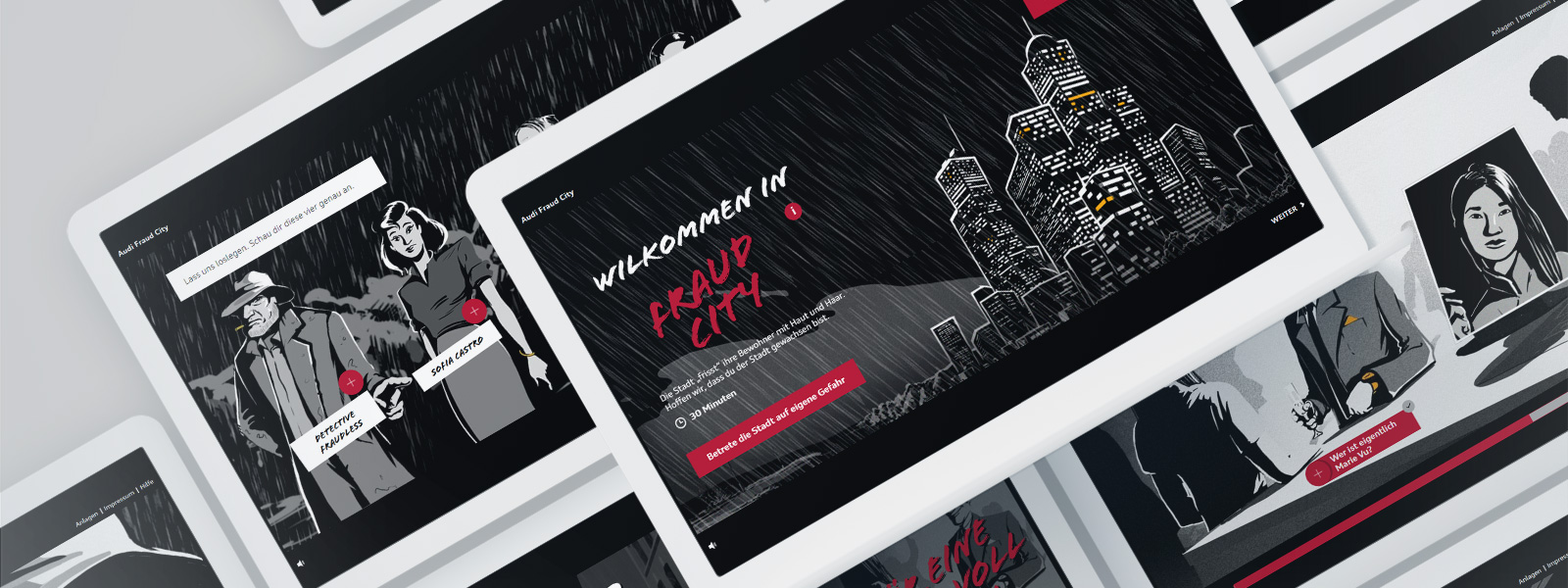
If you could choose again, would you still decide on the same job?
Yes. Absolutely. As I said earlier, I have always been very creative and love design. I enjoy it immensely. To balance out sitting at the computer all day, I like to head out into the great outdoors to practice landscape and animal photography and soak in nature. It helps me switch off completely.

Please complete this sentence: When dealing with colleagues, what matters the most is ...
I think it is particularly important to address problems directly, so that solutions can be found as quickly as possible. It is also important to always be open and honest with each other and avoid taking yourself too seriously. It’s OK to laugh about your own mistakes.
What are you looking forward to each day the most?
I am a total morning person and love a good breakfast. When I check my emails in the morning, I always eat something tasty - muesli with raisins, bread with spread or such. On the weekend, I might have eggs or pancakes. But without breakfast, I simply can’t function.

What’s your take on digitalisation?
I’m a little torn. Of course, I spend a lot of time in front of the computer in my job, and there are many positive aspects – especially in these times. We must be thankful that we can already do so many things online, from shopping to video conferences. However, it’s still not the same as meeting someone in person.
For example, in the project I described earlier, it was such a beautiful feeling to work together – to draw on a whiteboard together, make corrections, redesign, discuss as a team. The thought and work processes are different in the digital sphere. I don’t think you can reproduce or replace it.
Do you have an unusual gimmick at your workplace?
I do. I have an inflatable wedge cushion for my back. It’s like a sitting ball you place on the chair that makes you move. It really helped me.
Where can you be found in your lunch break?
In Freiburg, we have a big kitchen where we often used to cook together before corona. Properly. We would clean and cut vegetables, cook pasta, and eat together. One colleague also likes to bake, and he would use up all the bananas that had gone brown and make banana bread. We would often go for a walk after we had lunch. I really enjoyed that and hope it will soon be possible again.

Who would you say has the coolest office?
Other than our office in Freiburg, I’ve only seen the old offices in Saarbrücken. I do think our office with the large kitchen, many plants and windows offering a view of the Vosges is rather beautiful. Sometimes, it can get a little noisy when everyone is in.
But I like the open plan. There are no closed doors, and you can walk over to anyone at any time. Of course, I would really like to visit our Melbourne office ...
Taking about travelling, what country would you like to visit?
I’ve never been to the northern countries in Europe, like Finland, Sweden, or Norway. I would love to go mushing through the snow with sled dogs. I imagine that would be fabulous.
Thank you very much for the pleasant interview, Maren and all the best!

Career hoppers welcome
Conceptual or instructional designer, editor for digital learning: there are many names for his job.
In this interview Philipp tells us what he really does and why he needs a lot of tact and diplomacy for some clients.

Work or study?
How to become a Media Designer – with an Apprenticeship or degree? Vanessa Pesch also faced these question after having finished school.
In the job slot she tells, why she decided for an apprenticeship in imc's content team.
Would you like to know more about imc as an employer? Then take a look at our career section, maybe there is a suitable position for you.
We are also always happy to receive unsolicited applications!

Contact person
I have been working in the Marketing & Communication Team at imc since March 2019.
Communication, creating unique content and social media are my passion.
"One can not not communicate" - Paul Watzlawik.
To explain complex content in an understandable way and thus make the topic of e-Learning accessible to everyone is an exciting challenge every day.
Privately I love to read, play poker and travel a lot.
I am always happy to receive feedback or suggestions.
![[E-Learning Punk] Exploratory 3D Learning](https://images.im-c.com/wp-content/uploads/2021/02/imc_image_elearningpunk_3Dlearning_hero.jpg)
Exploratory 3D Learning
Spatial depth brings profound changes to the world of professional development

Digital 3D professional development
Maximum educational value x3
- Interactive and exploratory learning in virtual space
- Independent exploration of a visually appealing world
- Experiencing the immediate consequences of actions
Application scenarios for 3D Learning x3
Onboarding
In large corporations, a 3D map can provide initial orientation to the various corporate divisions which are displayed on a kind of city map, for example.
Product training
A 3D map makes it possible to vividly present products and services to clients, partners and employees in virtual showrooms – and not only during lockdown. AR spots make the integration of virtual and physical worlds turn out particularly well.
Security training
3D Map supports efficient training for appropriate behaviour in crisis scenarios such as a fire in the building.
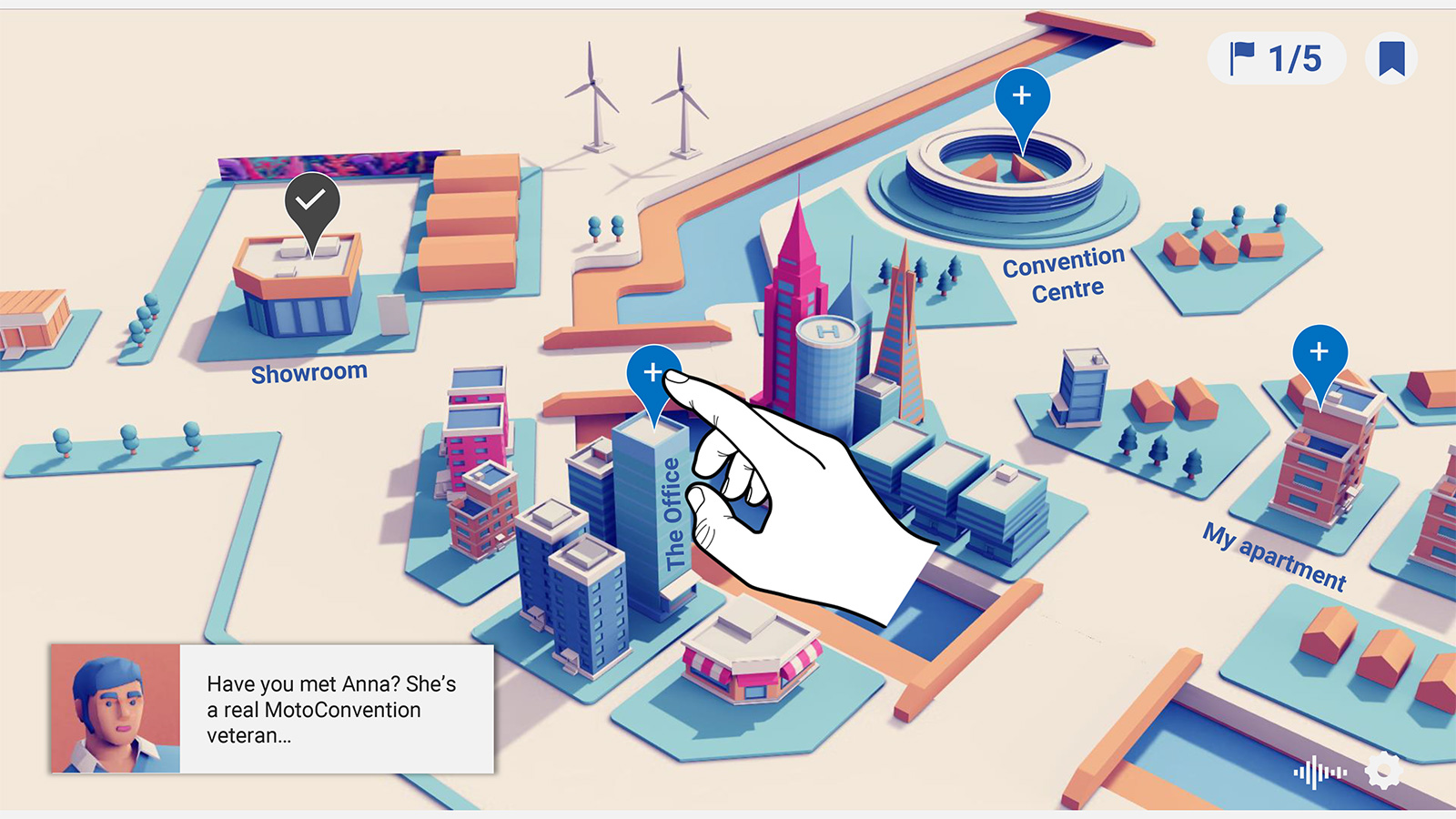
Another concrete example for the use of the imc 3D Map is a virtual world called "Moto City".
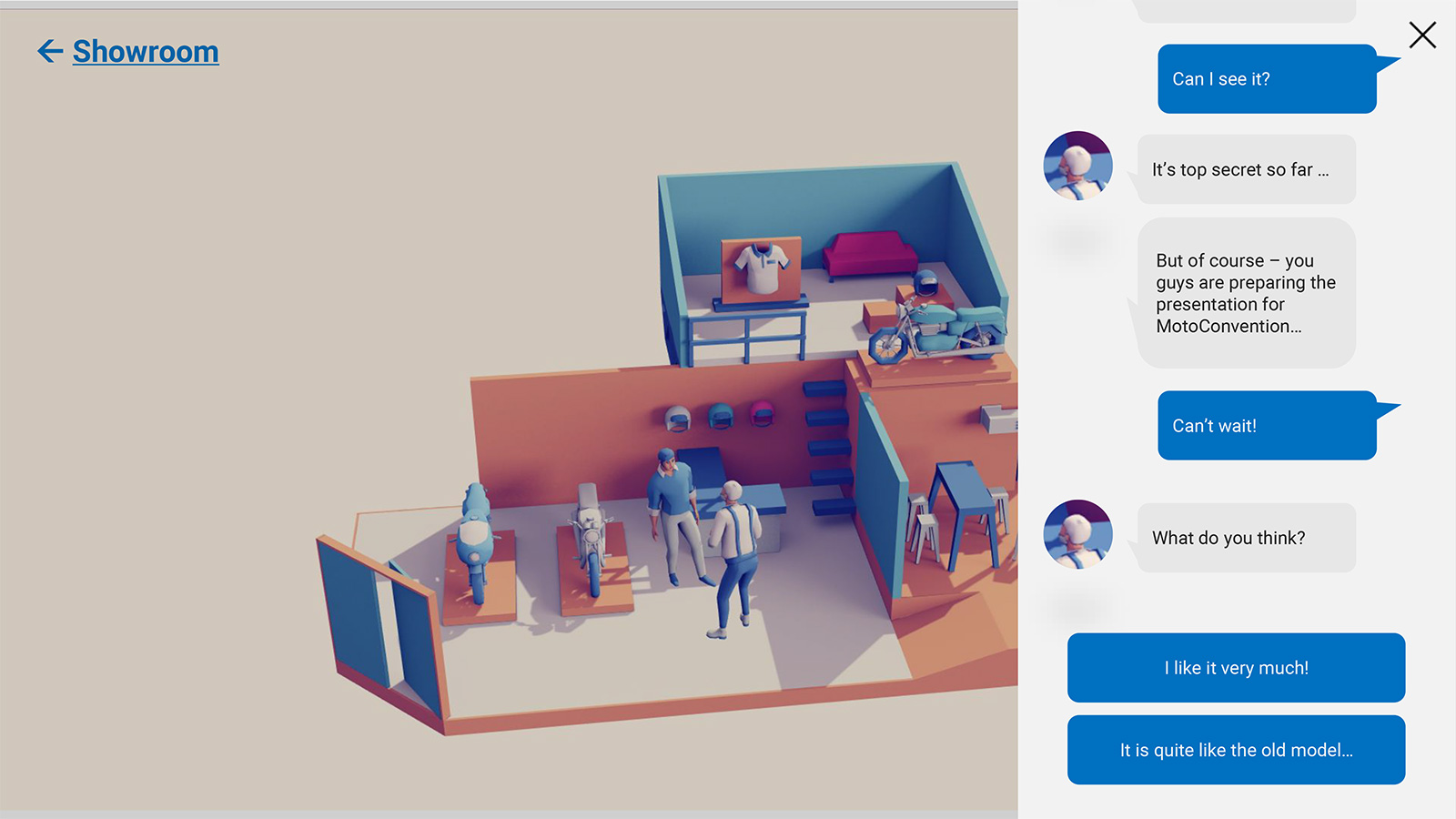
Another concrete example for the use of the imc 3D Map is a virtual world called "Moto City".

Another concrete example for the use of the imc 3D Map is a virtual world called "Moto City".
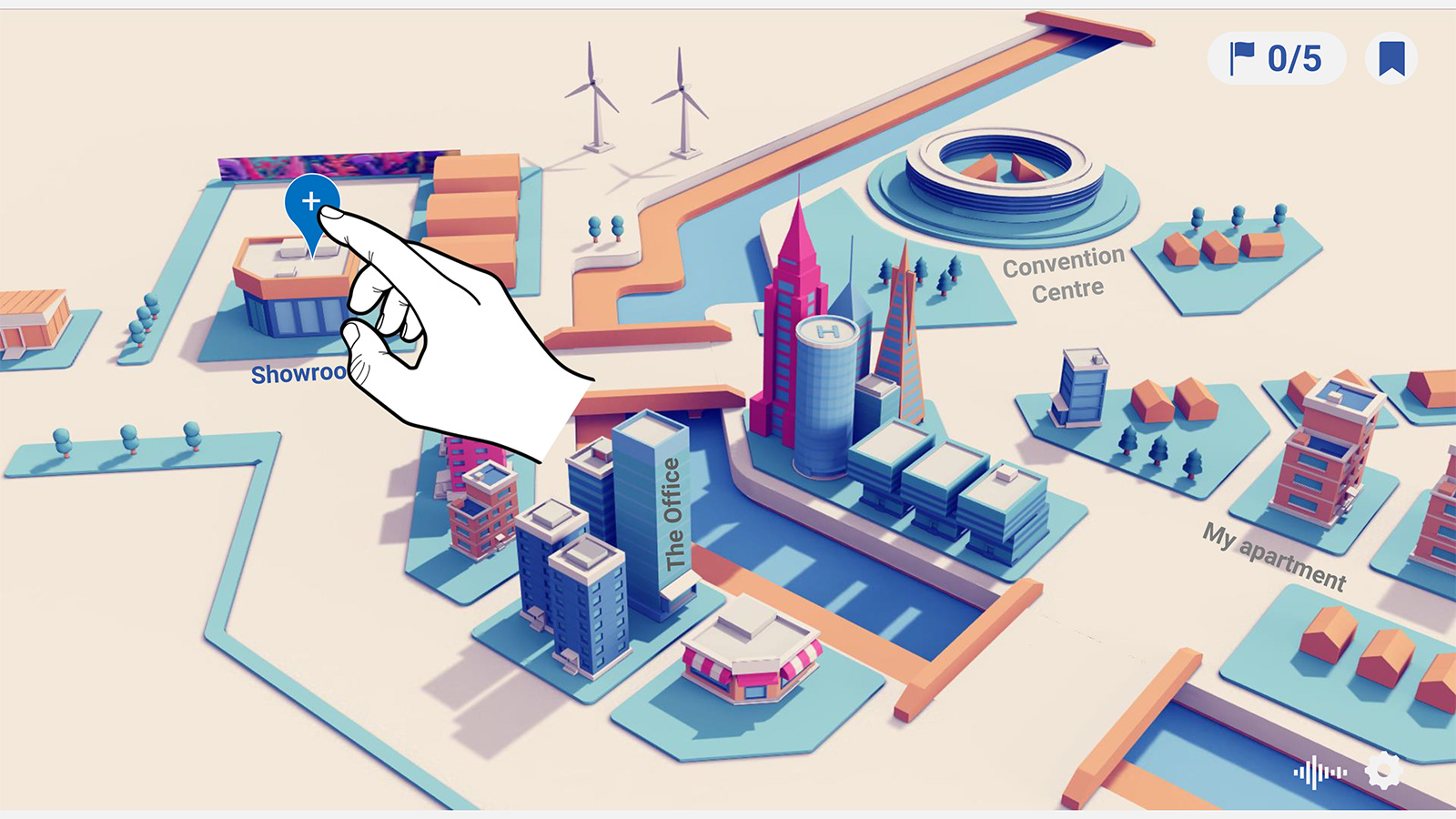
Another concrete example for the use of the imc 3D Map is a virtual world called "Moto City".

Another concrete example for the use of the imc 3D Map is a virtual world called "Moto City".
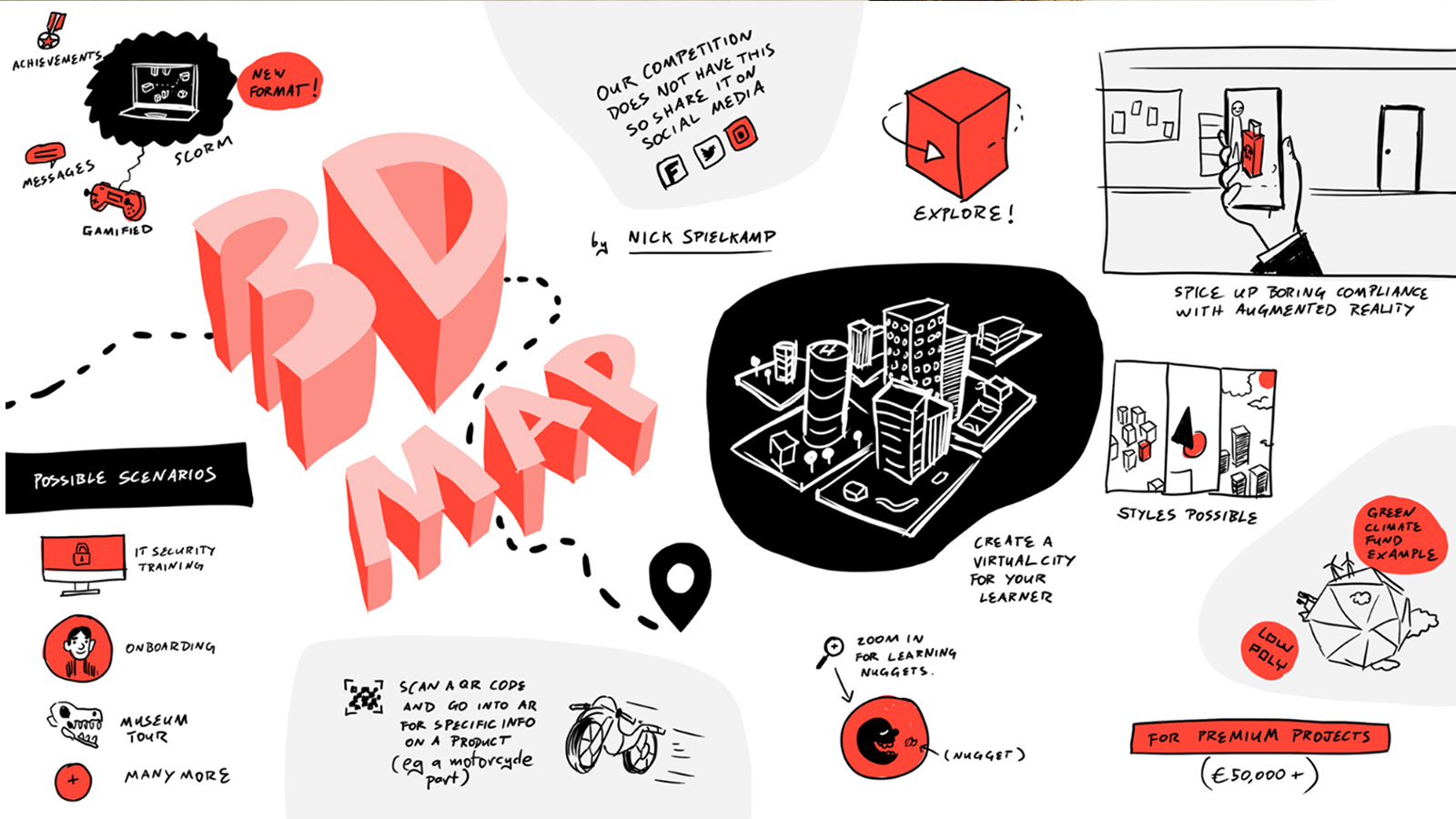

Contact person


